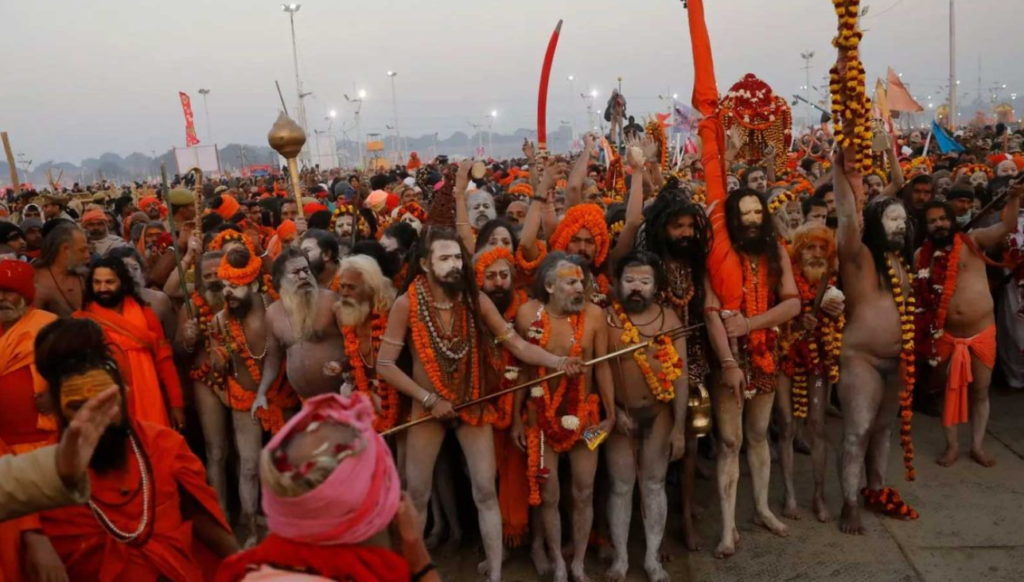The Mahakumbh, one of the largest spiritual gatherings in the world, is a magnificent confluence of faith, culture, and tradition. Held in India, this event transcends religious practices, drawing millions from across the globe who seek spiritual awakening and a sense of community. Steeped in history and mythological significance, the Mahakumbh encapsulates the essence of India’s diverse spiritual heritage. I certainly want to be there and witness the spectacular event. Do you? If so read on this article will give you a glimpse of Mahakumbh and how to reach there.
Historical and Mythological Significance
The origins of the Mahakumbh trace back to ancient Hindu scriptures, particularly the Puranas. According to legend, during the cosmic churning of the ocean (Samudra Manthan) by the gods and demons, the pot (Kumbh) containing the nectar of immortality (Amrit) emerged. A fierce battle ensued for the possession of this pot, during which drops of nectar fell at four locations: Prayagraj, Haridwar, Ujjain, and Nashik. These sites became sacred grounds for the Kumbh Mela.
The Mahakumbh, held once every 12 years in Prayagraj (formerly Allahabad), is the grandest of these gatherings. It is based on specific astrological alignments, with Jupiter entering Aquarius and the Sun entering Aries marking the auspicious period. Smaller iterations, including the Ardh Kumbh (every six years) and Magh Mela (annual), also hold significant spiritual importance.
The Story Behind Kumbh Mela
The story of the Kumbh Mela originates from the celestial event of Samudra Manthan (churning of the ocean). According to Hindu mythology, the gods and demons collaborated to churn the ocean for Amrit, the nectar of immortality. Using the mountain Mandara as a churning rod and the serpent Vasuki as a rope, they churned the ocean, producing a series of divine treasures and potions.
As the Amrit emerged, the gods realized the need to protect it from the demons. Lord Vishnu took the form of Mohini, a divine enchantress, to distribute the nectar. However, during the pursuit and skirmish over the pot, drops of Amrit spilled at four earthly locations: Prayagraj, Haridwar, Nashik, and Ujjain. These sites became sacred pilgrimage destinations where the Kumbh Mela is held.
The Shahi Snan (Royal Bath)
The Shahi Snan is the most significant ritual of the Mahakumbh, marking the culmination of religious fervor and devotion. It refers to the ceremonial bathing by saints, sadhus, and Akharas (religious orders) at the confluence of the holy rivers. This ritual holds profound spiritual importance and symbolizes purification of the soul.

Spiritual Benefits of the Shahi Snan
- Cleansing of Sins: It is believed that taking a dip in the holy waters during the Shahi Snan washes away accumulated sins, paving the way for spiritual renewal.
- Path to Moksha: The ritual is considered a step towards attaining moksha, or liberation from the cycle of birth and death.
- Enhanced Spiritual Energy: Bathing during the auspicious planetary alignments imbues devotees with positive vibrations and spiritual energy.
- Community Unity: Participating in the Shahi Snan fosters a sense of belonging and unity among the millions who gather for the same purpose.
- Renewal of Faith: The act reinforces faith and devotion, rejuvenating spiritual practices for individuals and communities alike.
Sequence of Events During Shahi Snan
- Royal Procession: The Akharas lead a grand procession to the riverbanks, accompanied by music, chants, and vibrant displays of devotion. Adorned with saffron robes, garlands, and holy ashes, the saints often ride on elaborately decorated chariots or elephants.
- Priority Bathing: The sequence of bathing is pre-determined, with the Juna Akhara usually taking precedence, followed by others in a specific order. This hierarchical arrangement reflects centuries-old traditions.
- Public Participation: After the Akharas complete their baths, pilgrims are allowed to take their holy dips. The act of bathing is believed to cleanse sins and pave the way for salvation.
The Shahi Snan days are marked by heightened spiritual energy and festivity, drawing massive crowds of devotees who throng the ghats (riverbanks) to witness or partake in the sacred ritual.
Significance of Mahakumbh (144 Years)
The Mahakumbh, held every 144 years at Prayagraj, is a rare and extraordinary event in the Hindu spiritual calendar. It is believed to be the most auspicious time for spiritual activities and carries unparalleled significance due to the unique planetary alignments that occur during this period.
Unique Aspects of the 144-Year Mahakumbh
- Rare Astrological Phenomenon: The Mahakumbh is marked by the confluence of extraordinary astrological configurations, amplifying its spiritual potency.
- Enhanced Spiritual Merit: Participating in the rituals and bathing during the Mahakumbh is considered to yield manifold spiritual rewards compared to regular Kumbh Melas.
- Cultural Legacy: This event serves as a bridge between generations, preserving and passing down ancient traditions and values.
- Global Attention: The rarity of the Mahakumbh attracts global pilgrims and scholars, fostering cross-cultural dialogue and understanding.
The Mahakumbh symbolizes the zenith of spiritual devotion and cultural unity, making it a once-in-a-lifetime opportunity for many devotees.
Rituals and Activities
At the heart of the Mahakumbh lies the ritual of the holy dip (Shahi Snan) in the confluence of the Ganga, Yamuna, and the mythical Saraswati rivers. Devotees believe that this act cleanses sins and facilitates liberation (moksha). The festival commences with the royal procession of Akharas, marked by chants, music, and colorful displays of devotion.
Apart from the holy dip, the Mahakumbh is a hub for religious discourses, cultural performances, and spiritual debates. Saints, scholars, and mystics share their knowledge, contributing to a vibrant intellectual atmosphere. Pilgrims also partake in charity, community feasts, and other philanthropic activities, reinforcing the festival’s ethos of unity and service.
Scale and Organization
The sheer scale of the Mahakumbh is awe-inspiring. It attracts millions of devotees, including foreign tourists, making it one of the largest peaceful gatherings on Earth. The event requires meticulous planning and coordination, with temporary infrastructure such as tents, sanitation facilities, and healthcare centers established across the venue. Security measures, traffic management, and environmental considerations are key aspects of the planning process.
Cultural and Global Impact
The Mahakumbh is not just a religious event but a cultural extravaganza. It showcases India’s rich heritage through art, music, dance, and cuisine. The festival has garnered global recognition, with UNESCO designating it an Intangible Cultural Heritage of Humanity. It serves as a platform for cross-cultural interactions, fostering mutual understanding and respect among diverse communities.
Traveling to the Mahakumbh: Delhi to Prayagraj

For those traveling from Delhi to Prayagraj for the Mahakumbh, the journey offers multiple options:
By Train
Prayagraj is well-connected by Indian Railways, and several trains operate between Delhi and Prayagraj, especially during the Kumbh Mela:
- Prayagraj Express: A popular choice, this train runs daily and offers comfortable seating and sleeping arrangements.
- Duronto Express: Known for its speed and minimal stops, the Duronto Express is an efficient option.
- Shram Shakti Express: Operating daily, this overnight train is convenient for those seeking a budget-friendly option.
Special trains are also introduced during the Kumbh Mela to accommodate the surge in pilgrims. It is advisable to book tickets well in advance through the Indian Railways’ official portal or authorized agents.
By Road
Several buses, including government and private operators, ply between Delhi and Prayagraj. The journey takes approximately 8-10 hours, depending on traffic and road conditions.
By Air
The nearest airport to Prayagraj is Bamrauli Airport, with regular flights from Delhi. From the airport, taxis and local transport options are readily available to reach the Kumbh Mela grounds.
Tips for Pilgrims
- Plan Ahead: Accommodation can be scarce during the Mahakumbh. Book tents, hotels, or dharamshalas in advance.
- Pack Essentials: Carry warm clothing, as the event typically coincides with the winter season. Other essentials include reusable water bottles, first aid kits, and basic toiletries.
- Stay Informed: Follow official updates regarding schedules, safety guidelines, and health advisories.
- Respect the Environment: Avoid littering and participate in eco-friendly initiatives to keep the sacred grounds clean.
Conclusion
The Mahakumbh is a testament to the enduring power of faith and the human spirit. It is a celebration of life, a pursuit of spiritual enlightenment, and a tribute to India’s timeless traditions. Whether one seeks divine blessings, cultural immersion, or simply a sense of belonging, the Mahakumbh offers an unparalleled experience that lingers in the heart and soul long after the event concludes.

Spiritual Reads:






its great as your other content : D, appreciate it for putting up.
A few things i have observed in terms of computer memory is that often there are specs such as SDRAM, DDR or anything else, that must fit in with the specific features of the mother board. If the computer’s motherboard is reasonably current and there are no operating-system issues, changing the memory literally will take under sixty minutes. It’s one of many easiest laptop or computer upgrade types of procedures one can imagine. Thanks for spreading your ideas.